
views
Using the Pet Door Properly

Choose a door that's 1 to 2 in (2.5 to 5.1 cm) bigger than your pet. Check your pet’s height and width with a measuring tape. Then, add 1 to 2 in (2.5 to 5.1 cm) to each one. Get a pet door in these dimensions to ensure that it will be the right size for your pet. This may help to prevent larger intruders from entering your home. For example, if your pet measures 18 in (46 cm) tall by 8 in (20 cm) wide, then a pet door that measures 20 by 10 in (51 by 25 cm) would be ideal. Warning: Never get a door that’s smaller than your pet because they may not be able to fit through it safely.

Place food and water bowls away from the pet door. Keeping your pet’s food and water dishes right beside the door may lure intruder animals in through the pet door. To avoid this, move the bowls to another location in your home that is well away from the pet door, preferably in another room. For example, if the pet door leads to the kitchen, you might keep your pet’s food and water bowls in the living room instead.

Lock the pet door when your pet is not using it. Most newer pet doors have a latch on them that allows you to lock the door when it is not in use. If your pet door has a latch, lock it when your pet won’t be using it, such as at night or when you take your pet somewhere. Make sure that the edges of the pet door seal tightly when it is closed. Inspect the edges before you latch the door.
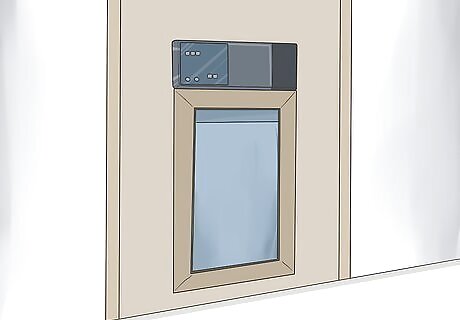
Consider getting an electronic door that will only open for your pet. If you’re interested in a high-tech solution to intruders, you could get an electronic pet door. These pair with a microchip on your pet’s collar so the door will only open for your pet. If another animal tries to get in, the door will remain locked and closed. Keep in mind that electronic pet doors cost around $150. They also require electricity or batteries to work.
Deterring Intruders
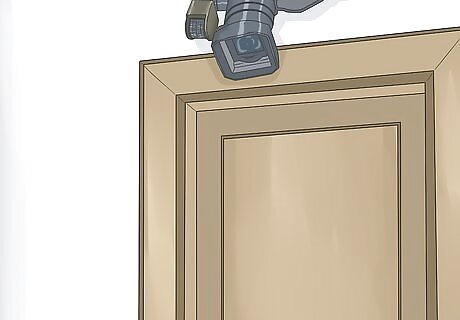
Install a motion-activated light above the door to frighten intruders. Many animals that might try to gain entry through your pet door at night, such as raccoons and stray cats, might be frightened off by a motion-sensor light. Purchase a motion-sensor light from a hardware store and install it above the door where the pet door is located. Another option is to get a motion-activated sprinkler if you have a lawn outside your door. This will spray water at any animals that approach the pet door. However, make sure to shut it off before your pets go outside again.

Sprinkle cayenne pepper outside the door. The spicy scent of cayenne pepper should keep intruder animals like raccoons, squirrels, and stray cats away from your door. However, your pet may also dislike the scent of this spice. Try sprinkling a bit of cayenne outside the door at night and then rinse it away with water in the morning before your pet goes outside. You could also try other powerful spices and herbs if you don’t have cayenne, such as cloves, peppermint, and cinnamon.
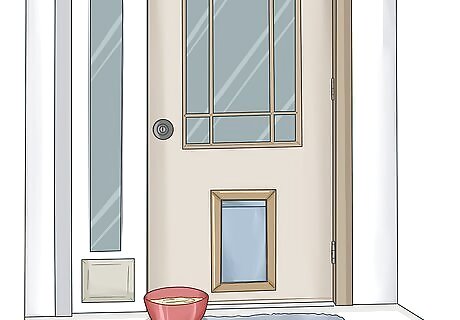
Place a bowl of apple cider vinegar next to the door at night. Apple cider vinegar is another powerful scent deterrent. Fill a small bowl with 8 fl oz (240 mL) of apple cider vinegar and place it just outside your pet door. Any animals that try to come in will have to deal with the scent and this may be enough to keep them away. Another option is to sprinkle apple cider vinegar in front of the door, but the scent may not be as powerful this way.Tip: If you don’t have apple cider vinegar, white vinegar will also work.
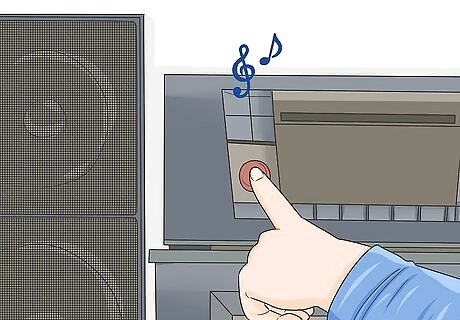
Turn on a radio and place it near the door before you go to bed. Intruder animals tend to try to get in at night when it’s quiet, but they might think twice about coming through a pet door if they hear the sound of human voices on the other side. If you’re unable to lock the pet door, turn a radio on to a talk radio station and place it beside the door. This may also be a good option if you’re going away for a few days and don’t have a way to latch the door. Another option is to switch on a television in the room where the pet door is located. You could also try placing wind chimes outside next to the door, but these won’t always make noise since they require a breeze to work.
Getting an Animal to Go Back Outside

Move your pets into a separate room and close the door. Try to remain calm and speak in a low, quiet voice as you do this. Close the doors to other rooms of your home as well, to prevent the intruder animal from gaining access to these areas. If you have a friend or family member who can help you, they could secure your pets while you work on removing the intruder.
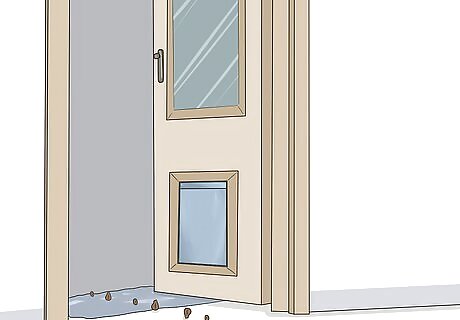
Create a trail of food leading to an outside door. Open a door and then drop a few pieces of food on the floor leading outside. This may be enough to lure the animal back outdoors. If the animal follows the trail, shut the door behind it once it is outside. You can use marshmallows, cereal, crackers, or any other food you have on hand.Tip: Sprinkle a bit of flour in front of a doorway so you will be able to see footprints leading out the door and know when the animal is gone.

Frighten the animal by making loud noises and turning on lights. Grab a metal pot and a spoon and bang it, or switch on a vacuum cleaner to frighten the animal towards the door. Turn on all of the lights in your home to create a bright environment as well. You might even switch a bright light on and off a few times to scare the animal towards the door. Even stomping your feet, clapping your hands, and yelling may be enough to spook the animal and get it to leave.

Call animal control if you can’t get the animal out or if it seems sick. If the animal won’t go outside and you’ve tried everything to get it to leave, call your local animal control for help. Also, make sure that you watch for signs of rabies in the intruder animal and be extra cautious if you spot any. Some common signs include: Seeming sick or injured Appearing lethargic Acting aggressively or being unusually friendly Having difficulty standing or walking Seeming confused or disorientated



















Comments
0 comment